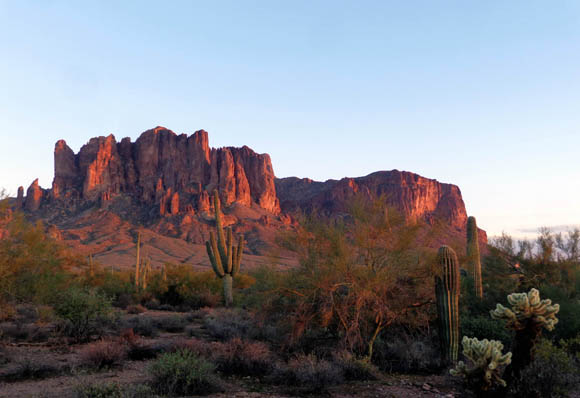This was our second and longest time to stay at Desert Eagle RV Park
at Nellis Air Force Base in northern Las Vegas, NV. We really liked this
campground when we first visited in April, 2016
but we weren't there long enough then to see some of the sights listed in the
quote above so this time we stayed for two weeks.
We have zero interest in the Vegas Strip but we did go to Hoover Dam,
Mt. Charleston, Springs Mountain Recreation Area, and the Thunderbird Museum,
which we didn't do three years ago. It was
fun to see some places that were new to us.
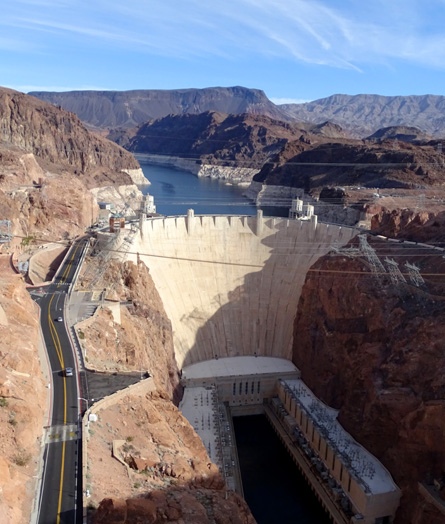
You can get an idea of Hoover Dam's size by
comparing it
with the vehicles
on the road to the left. 1-11-19)
I'll have entries on those places, as well as Lake Mead National
Recreation Area, Valley of Fire State Park, and Red Rock National Conservation Area.
Those were repeat visits for us because we enjoyed them last time.
A partial government shutdown that was in effect during our stay at
Nellis AFB had an impact on several places we wanted
to go while we were in the area. We were able to
drive through the three recreation and conservation areas despite the
shutdown, but no one manned the entrance stations and the visitor
centers, bathrooms, campgrounds, and some other things were closed.
This entry will feature the drive from Camelback Ranch in Glendale,
Arizona to Nellis AFB in Nevada; information about Desert
Eagle RV park, including additions since we were here
last
time; and our visit to the USAF Thunderbird Museum (shown
below), which was closed for renovations when we were here in 2016.
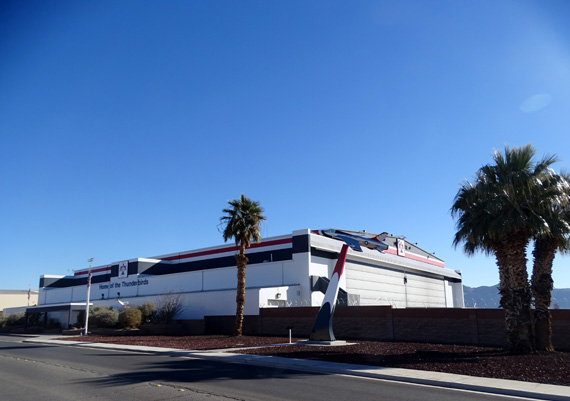
The Thunderbird Museum wasn't affected by the government shutdown but
I think their aerial demonstration schedule was.
CAMELBACK RANCH TO NELLIS AFB
Jim finished his 100-mile walking event at
Across the Years (ATY) at Camelback Ranch about 4AM on
Sunday, got a couple hours of rest in our camper, ate breakfast, and
prepared to leave the venue. We drove out fifteen minutes before the
next wave of runners began their events so we could avoid driving past
them on the few hundred yards where we'd be sharing the course.
The next picture shows the section I'm talking about. I put a red dot
over Jim's head; he was walking the event on his first day:
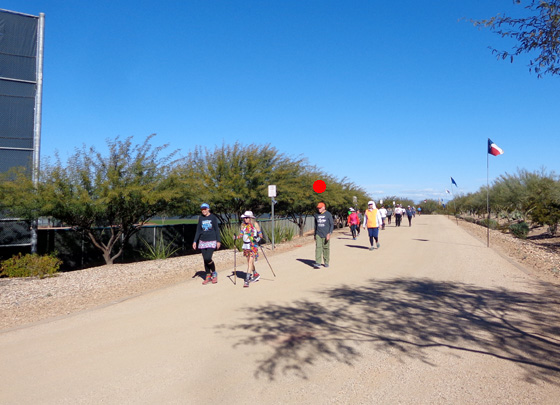
As tired as he was, Jim insisted on driving first because he wanted
me to navigate through the western side of metro Phoenix until we got on
US 60 heading northwest to Las Vegas. Yes, we had our GPS running but we
can't always count on it. I'm still old-school and like to use paper
maps as supplements to what "Gabby" is telling us to do.
Jim was able to stay awake and concentrate on hauling the 5th-wheel
but after about an hour his hands started cramping from lack of fluids
and he had to pull over.
I drove the next four hours until we got into Las Vegas so Jim could
drink fluids and take a nap. Before he went to sleep I asked him to take
a couple pictures of some of the Joshua trees (below) and saguaro cacti
we passed on US 60:
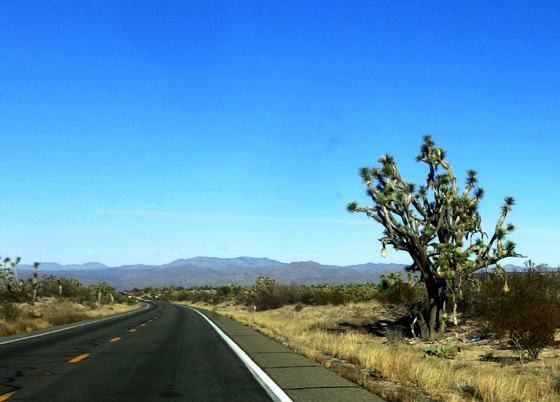
We followed scenic, hilly US 60 and US 93 through western Arizona. US
93 morphed into I-11, then I-515 in metro Las Vegas. We took I-15 north
through the city to exit 48, east on Craig Road, north on N. Las Vegas
Blvd., left on Range Rd. and into the gate on Nellis AFB that leads to the RV
park.
This route is faster than it may look on a map. Most of the roads are
four-lane or have passing lanes to get around slower vehicles like ours.
The only slow parts are through iconic old Arizona towns like Wickenburg
and Kingman and the area near Hoover Dam and Lake Mead.
It was our first time using most of this route. Despite the long ups
and downs, it's fine for RVs of any size as long as the roads are as
smooth as they are this year.
We loved all the mountains and canyons along this route, especially
as we got closer to Hoover Dam and Lake Mead:
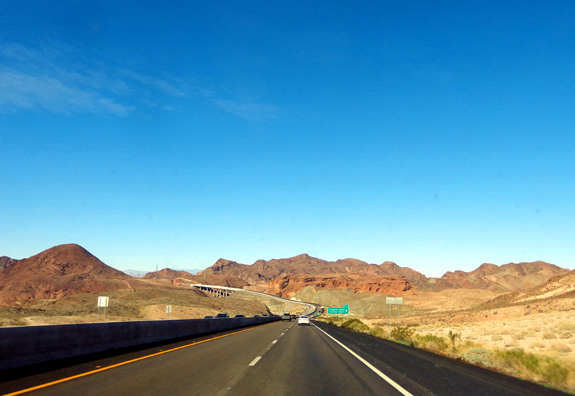
On a pretty Sunday afternoon at the end
of the holiday week we could see a large crowd at the dam overlooks and
down at the dam itself. We knew we'd have to visit the dam on a weekday
while we were at Nellis, not a weekend.
DESERT EAGLE RV PARK
Like almost every military RV park or campground where we've stayed, you either
have to have a military connection -- active duty, reserves, retired, DoD employee
-- or be a guest of someone in those categories, and then
only on a space-available basis.
This time of year, when Las Vegas isn't an inferno, no guests are permitted in
this RV park and you pretty much need advance reservations to get a spot even
if you're military-related.
The partial government shutdown that occurred while we were at Nellis AFB caused
this RV park to be even more crowded than normal in January because national park
campgrounds and national forest/BLM camping areas were closed. Campground hosts
working in the office told us they had to turn away some military retirees
who needed another place to go during the shutdown because this RV park was
already full almost every day.
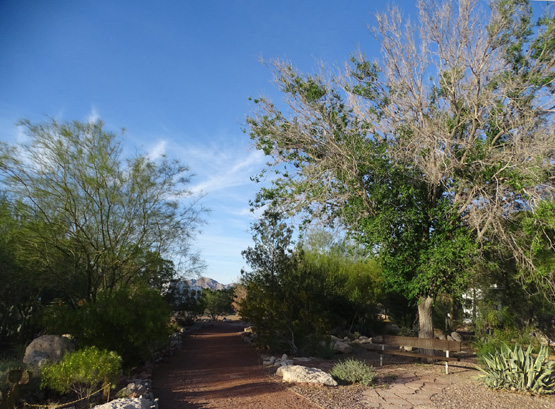
Lots of greenery behind our site
When we were here about three years ago we lucked out with a large, nicely-landscaped
site in one of the large circles with long pull-through and back-in sites:
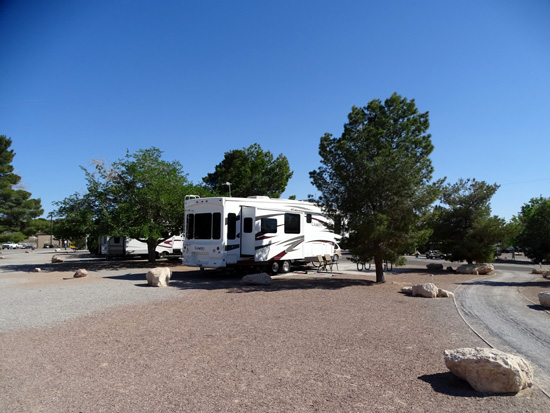
Our spacious site in 2016
These older sites used to be occupied by mobile homes before the area became
an RV park.
At that time about 40% of the sites were situated around six small circles
of grass with RVs parked "wagon-wheel" fashion around the perimeter,
usually with their doors toward the inside grassy area.
Unfortunately, that's where the utility hookups were located, not off-doorside where you
wouldn't trip over them or smell the sewer! In addition, the off-doorside was right on
the campground roadway. There was no privacy, no room (campers were parked pretty much
bumper-to-bumper), and no safe exit if you had your door toward the outside so the
utility connections were on the correct side.
Who comes up with these unsuitable designs??? They obviously weren't RVers.
Here's a picture from 2016 with two Class As illustrating these problems:
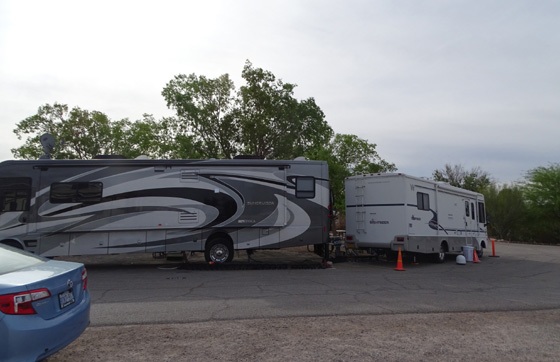
The rig on the left had its door facing the grassy circle but the
occupants had to run their power cord, water hose, and sewer hose under
the RV to hook them up -- near their door. Yuck! The motorhome on
the right parked so its hookups were on the correct side but the
occupants risked getting run over every time they stepped out their door
onto the campground street.
I felt sorry for everybody that had to park in the wagon wheels.
We knew before our arrival this year that only two of the original six wagon wheels were left,
designated Circle 5 and 6 on the diagram below. Now there are just four spots
located around each of those two little circles, not six or eight spaces as in
the past. Most of that area has been nicely re-landscaped and dozens of new
pull-through sites were built there and on some adjacent vacant land.
That's the good news for customers -- more sites. Here's a diagram of the
new layout:
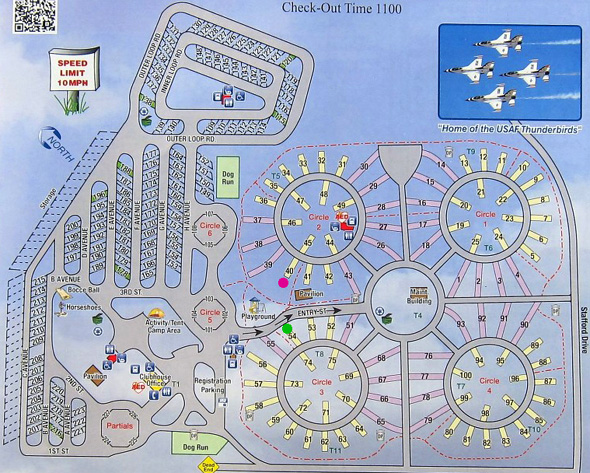
The older, larger sites radiate in or out of Circles 1 through 4 on the right side of the diagram.
Our site in 2016 is marked with a green dot; I used a purple dot right above
it to mark our current site. Two of the old wagon-wheel circles (5 and 6) and
dozens of new pull-through sites are on the left side of the park map.
The bad news, in our opinion, is that the new sites are
uncomfortably close together, sometimes with one site's sewer
connection right next to the adjacent site's RV door and picnic table. It's
bad enough if you're sitting next to your OWN sewer connection;
it's worse if it's your neighbor's!!!
You can see in the diagram above how tight those spots are compared to
the ones in the large circles on the right.
The new sites are definitely better than those old wagon wheels but
still not where we'd want to park even overnight. Reminds us of some poorly-designed
RV parks we've visited around the U.S. and Canada where the owners just try to cram as many
sites into the available acreage as possible for higher revenue.
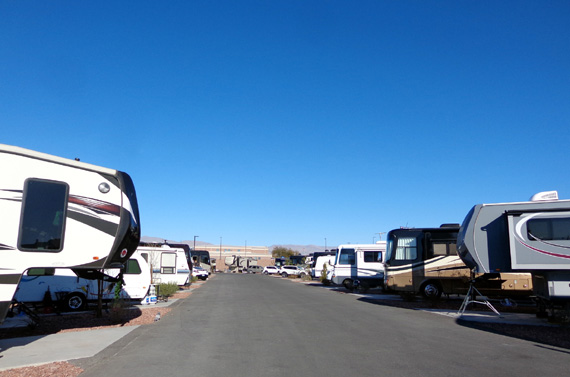
When you reserve a spot even the max of six months in advance at Desert Eagle you
can't reserve a particular site or even request to be in the old area in a large
site. Those tend to be reserved for seasonal visitors in the winter and we were only
going to be there for two weeks. We fully expected to be in one of the
narrow pull-thrus in the new section.
So imagine our surprise and delight when we totally lucked out AGAIN and were
assigned to what I think is one of THE BEST sites in the whole place, with
lots of space and shade and privacy:
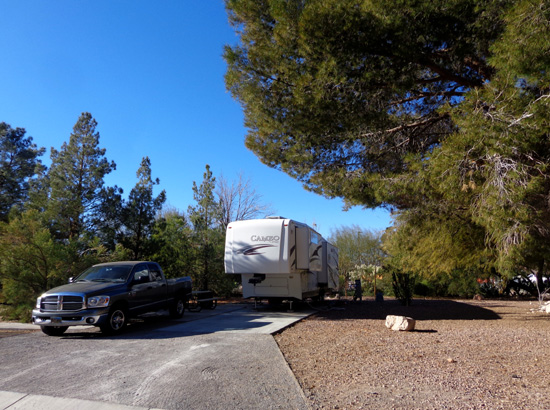
Our current site
This site was perfect for us and the dogs. I liked it even
better than the one we had previously.
Our cost was $24/day = $336 for two weeks for full hookups, 50-amp electricity,
and WiFi, although we used our unlimited Verizon mobile hotspot for security online.
We really appreciated having a sewer connection because Nellis was the only place
on this trip where we had that amenity.
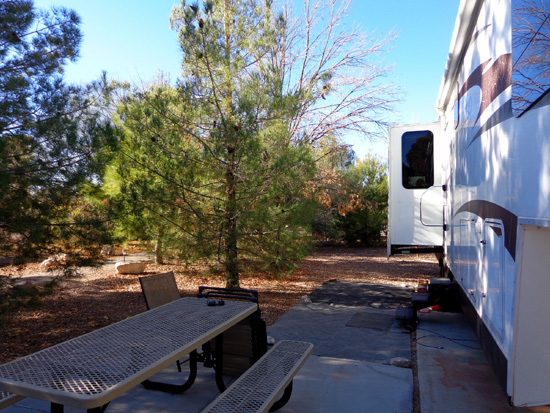
Our door side: quiet and shady
I wrote in 2016 that Desert Eagle puts the "park" in "RV park." It
has beautiful mature landscaping in the older area where we stayed. Although there
weren't as many flowers in bloom in early January as there were when we were here
in April three years ago, the place is still green and very attractive in the winter.
Lots of folks spend the whole winter season here, although it gets colder than
places farther south where many RVing snowbirds prefer to stay.
In addition to the trails we hiked off-base, we got out a couple times every
day to walk the dogs on the path around the perimeter of the "old"
part of the RV park (next picture) and through rows of new sites.
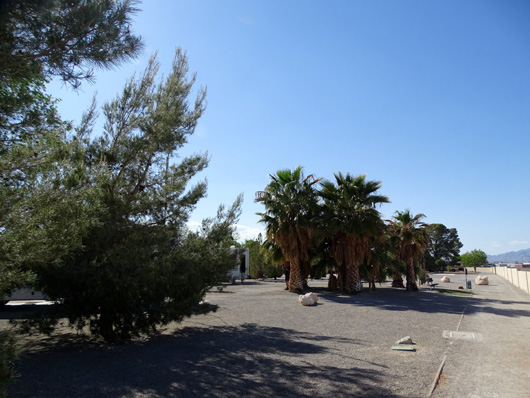
We also used a relatively small fenced dog park near the office a few times.
There is a limit of three dogs in the dog park at a time so when it was "full"
we just walked on by and tried another time. It was the only place where we could
let Holly and Casey play off-leash or retrieve balls:
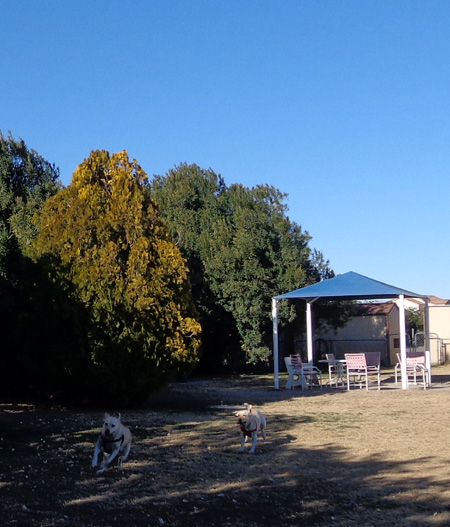
Despite our great campsite, we didn't have as good a time while we were here as
we'd hoped.
There were quite a few frustrations including the weather (unseasonably
cold), the partial government shutdown, a couple cranky campground hosts,
inadequate laundry facilities because the campground was so full, appointments
that got cancelled, poor internet connections with both our mobile hotspot and the
campground WiFi, various truck and camper issues I'll discuss at the end of the
trip, and all the water in the RV park being shut off the last two days we were here.
Some folks who didn't want the inconvenience for the six days the water was shut off
griped about it and moved to motels for the duration, then came back. No refunds were
given.
The water shut-off didn't affect us as much because we were
leaving two days after it began and we're more used to living without hookups than
many of the other RVers. Six days would have been a problem for us, though. We filled
our tank with enough water for the two days we had remaining and did our laundry in
one of the laundry rooms well before the water was shut off.
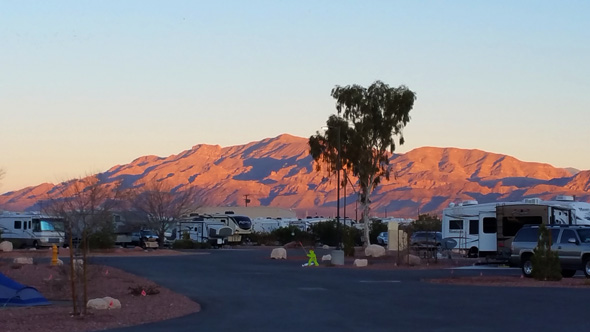
Sunset on the hills beyond the RV park
The bright spots during our stay at Nellis AFB were the day trips we took, despite some
limitations because of the partial government shutdown. We also went off-base to do
most of our shopping.
While on base we used the commissary, BX, Subway, and visited the Thunderbird Museum.
Noisy F-16s flying overhead were not a problem for us; some visitors complain
about noisy F-16s and other aircraft flying around on Air Force bases but we
are used to them and like the "sounds of freedom."
THE THUNDERBIRDS
We have been privileged to see the Air Force Thunderbird and Navy Blue Angel
demonstration teams perform several times over the years at various military RV parks
where we've stayed. We didn't plan any of those times; all were serendipitous
occurrences except one repeat visit to the Air Force Academy in Colorado Springs.
We've seen formal Thunderbird air shows at Ellsworth AFB in South Dakota and at
Joint Base Elmendorf-Richardson in Anchorage, Alaska; Thunderbird training
before and fly-overs during graduation at the Air Force Academy graduation twice;
Thunderbird training here at Nellis AFB this month . . .
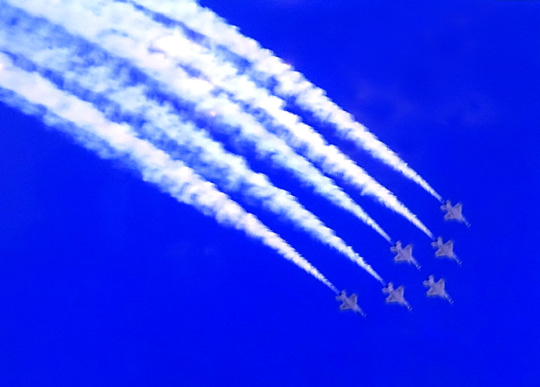
. . .
and Blue Angel training at the Naval Air Station in Pensacola, FL on two different trips.
Nellis is the Thunderbird Demonstration Squadron's home base for most of the year. There
is a small museum on the main part of the base with exhibits and videos that showcase the history of
the team and how the air men and women are trained.
The Thunderbird Museum was closed for remodeling when we were here in 2016 but it was
open this time. No one else was there on the weekday we visited. The public can visit
the museum with proper ID to get on base. Admission is free.
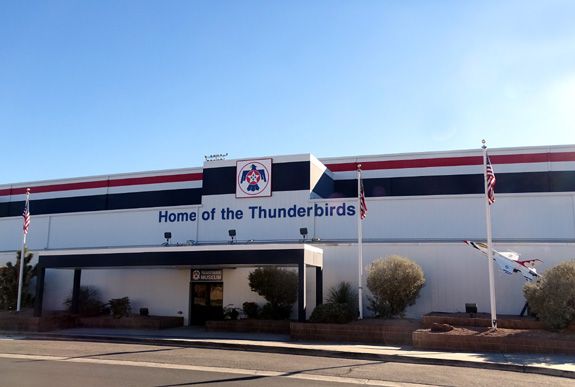
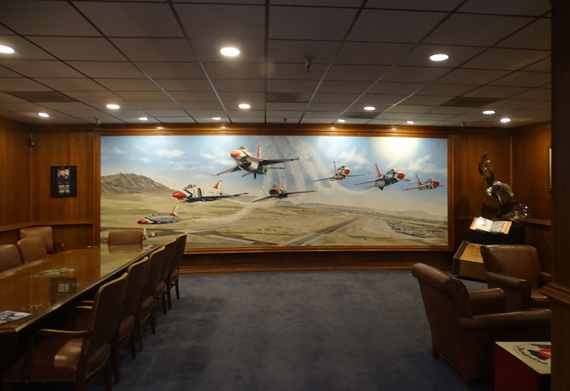
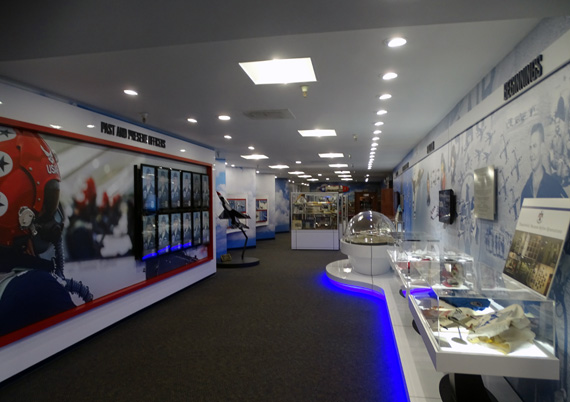
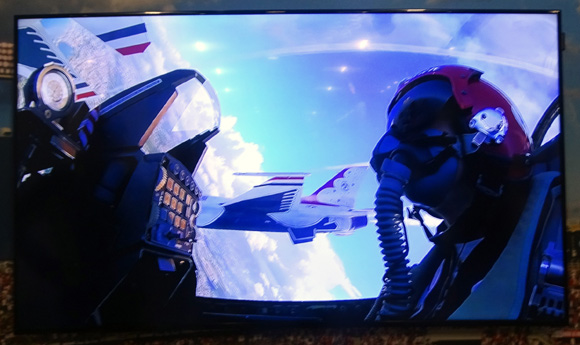
I smiled when I saw a display with the 1996 Olympic torch, which
was carried by team members during the Torch Run through Cheyenne, WY prior
to the Games:
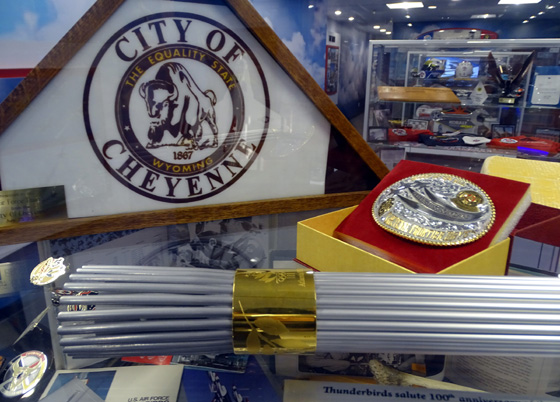
I have one just like it from when I carried the torch in Stone
Mountain, GA on the night before the Games opened!
That's one of the highlights of my life. I also volunteered at running, cycling,
and equestrian events every day of that Olympics. I lived in the Atlanta area
from 1974 to 1999, before I met Jim.
One Thunderbird F-16 is in a static display outside the museum, near the
entrance:
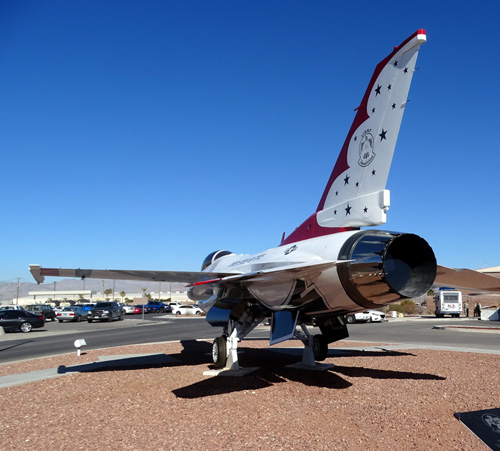
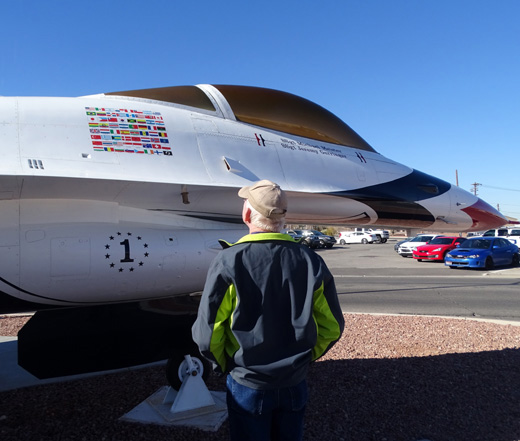
We were able to walk pretty close to the flight line to see
some of the Thunderbird's F-16s on the ground. One of the congenial team members
who was walking
by answered questions we had.
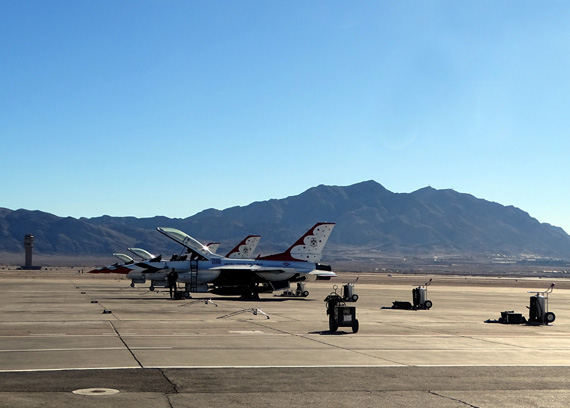
Some of the F-16 Fighting Falcons
used by the Thunderbird Air
Demonstration Squadron
If you're in Vegas and interested in learning more about the Thunderbird
Demonstration Squadron, it's worth your time to go on-base and visit this
small museum even if you aren't staying at the Desert Eagle RV Park.
Next entry: day drive up Mt. Charleston and the Springs
Mountain National Recreation Area to play in the snow and see the valley views
Happy trails,
Sue
"Runtrails & Company" - Sue Norwood, Jim O'Neil,
Casey-Girl, and Holly-Pup
Previous
Next
© 2019 Sue Norwood and Jim O'Neil
